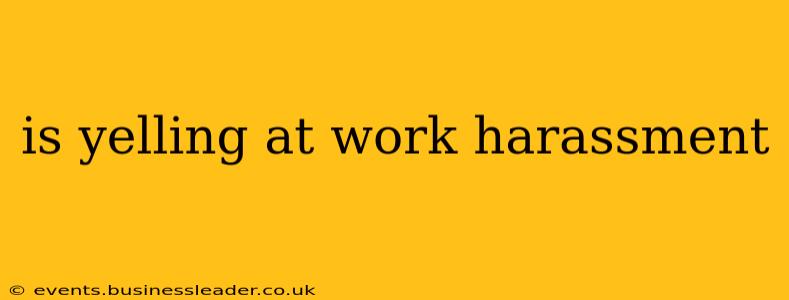Yelling at work is a serious issue, and whether it constitutes harassment depends on several factors. While a single isolated incident might not be classified as harassment, repeated or severe yelling can create a hostile work environment and be considered a form of workplace bullying or harassment. This article explores the nuances of yelling at work and its implications under the law.
What Constitutes Harassment in the Workplace?
Workplace harassment is any behavior that creates a hostile, intimidating, or offensive work environment. This can manifest in many forms, including:
- Verbal harassment: This includes yelling, insults, threats, intimidation, and offensive jokes.
- Physical harassment: This involves unwanted physical contact, assault, or threats of physical harm.
- Visual harassment: This includes offensive images, posters, or gestures.
- Psychological harassment: This encompasses bullying, intimidation, humiliation, and isolation.
Yelling, in isolation, might not always qualify as harassment. However, the context is crucial. Frequent, loud, and aggressive yelling aimed at a specific individual can definitely cross the line into harassment.
Is Occasional Yelling Harassment?
Occasional yelling, especially in high-pressure situations, might not be considered harassment. However, the intent and impact are vital considerations. If the yelling is unintentional, a single outburst might not be a problem. But if it's a regular occurrence, even if seemingly unintentional, it can contribute to a hostile work environment.
When Does Yelling Become Workplace Harassment?
Several factors determine whether yelling constitutes workplace harassment:
- Frequency: How often does the yelling occur? Regular outbursts are far more concerning than rare incidents.
- Intensity: How loud and aggressive is the yelling? Screaming and shouting are more serious than simply raising one's voice.
- Target: Is the yelling directed at a specific individual or group? Targeted yelling is often a sign of bullying or harassment.
- Impact: How does the yelling affect the recipient? Does it cause stress, anxiety, fear, or humiliation? The impact on the individual is a key factor.
- Context: Was the yelling justified by the situation? While some professions might involve occasional raised voices, this shouldn't be an excuse for consistent abusive behavior.
What are the Legal Implications of Yelling at Work?
The legal implications of workplace yelling depend on local laws and regulations. However, many jurisdictions have laws prohibiting harassment and discrimination in the workplace. If yelling creates a hostile work environment, legal action may be possible. This could include filing a complaint with the relevant authorities or pursuing a civil lawsuit.
How Can I Address Yelling at Work?
If you experience yelling at work, there are several steps you can take:
- Document the incidents: Keep a record of when, where, and how the yelling occurred. Include specifics, such as the content of the yelling and the impact it had on you.
- Speak to the person: If you feel comfortable, you can try speaking to the person doing the yelling to express your concerns.
- Report the behavior: Report the behavior to your supervisor, HR department, or a union representative.
- Seek support: Seek support from friends, family, or mental health professionals to cope with the stress.
What if the Yelling is From My Supervisor?
Yelling from a supervisor can be particularly problematic because of the power dynamic. In such instances, reporting the behavior is especially crucial. Your organization should have policies and procedures for addressing such situations. Do not hesitate to utilize them.
Conclusion
Determining whether yelling constitutes harassment requires careful consideration of the context, frequency, intensity, and impact. While occasional raised voices might be acceptable, persistent and targeted yelling is a serious issue that can lead to legal repercussions and a hostile work environment. If you are experiencing this issue, take the necessary steps to protect yourself and report the inappropriate behavior. Remember to document everything and utilize the resources available to you within your workplace.
